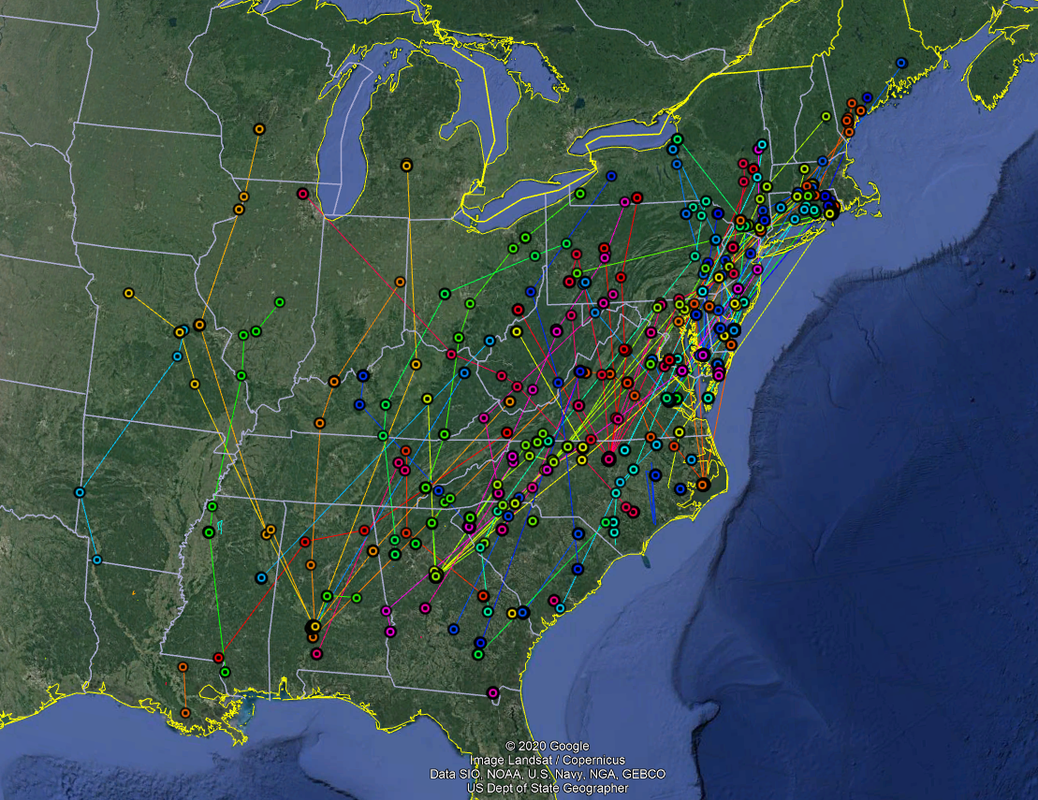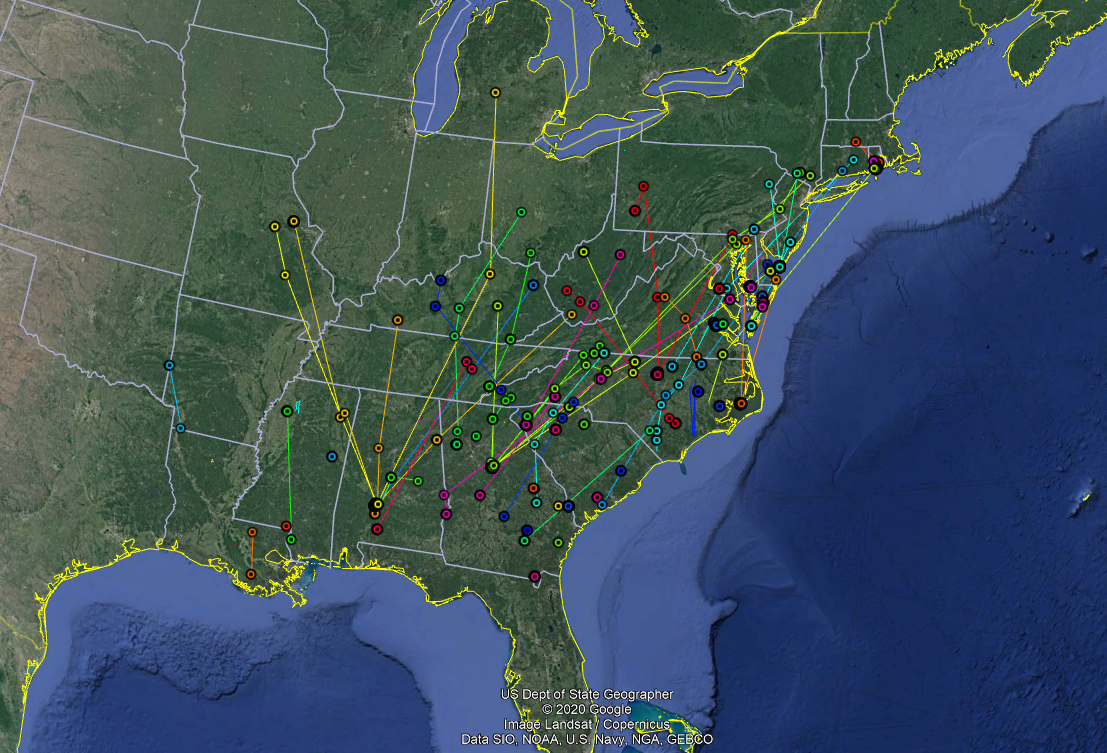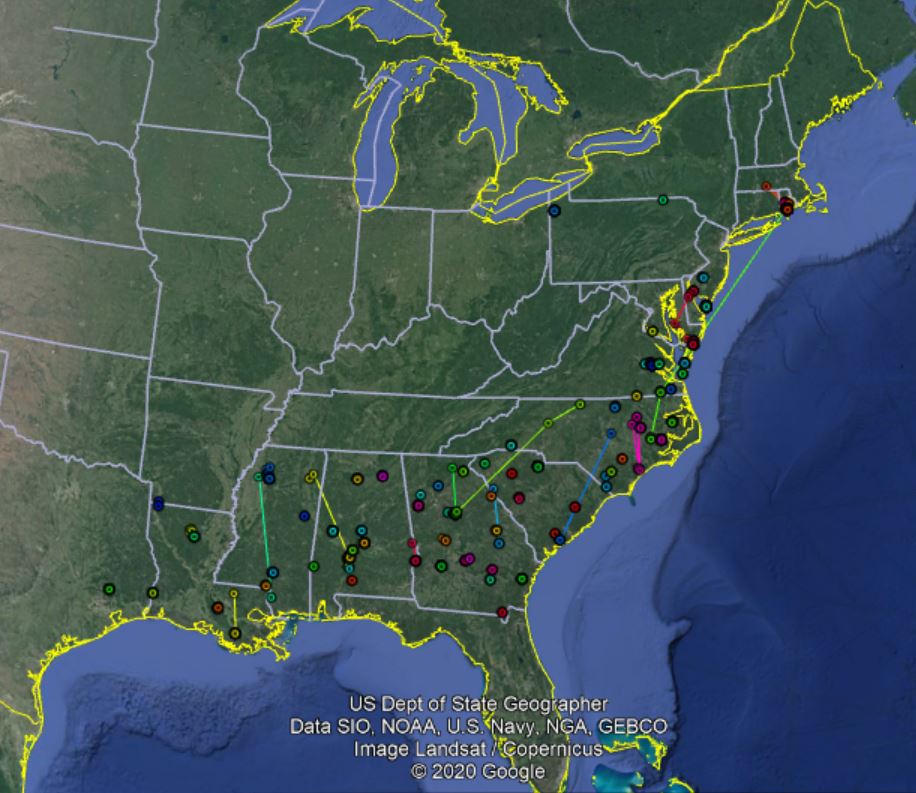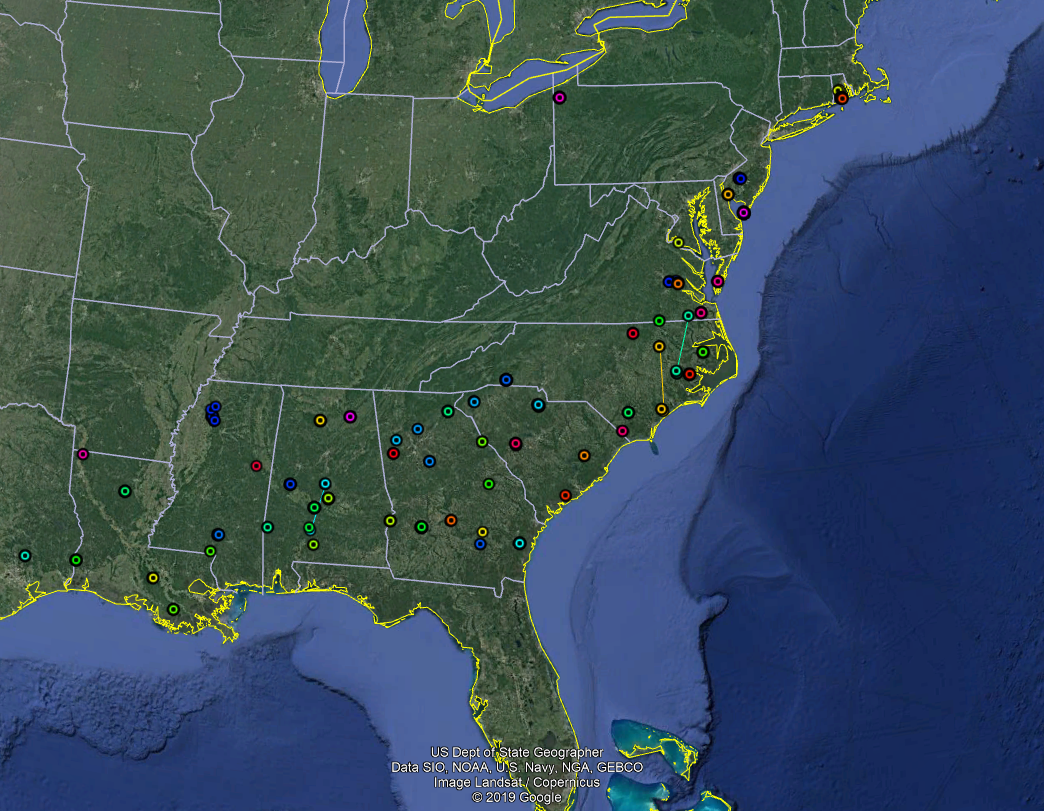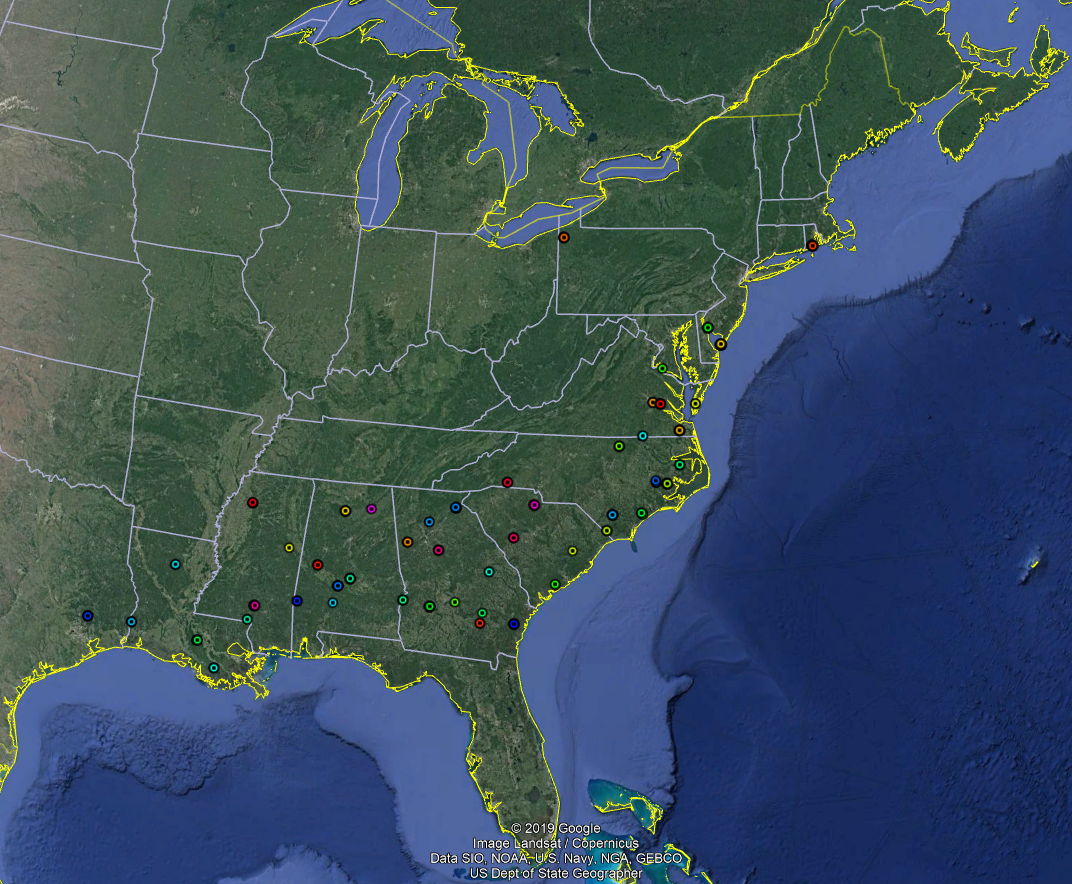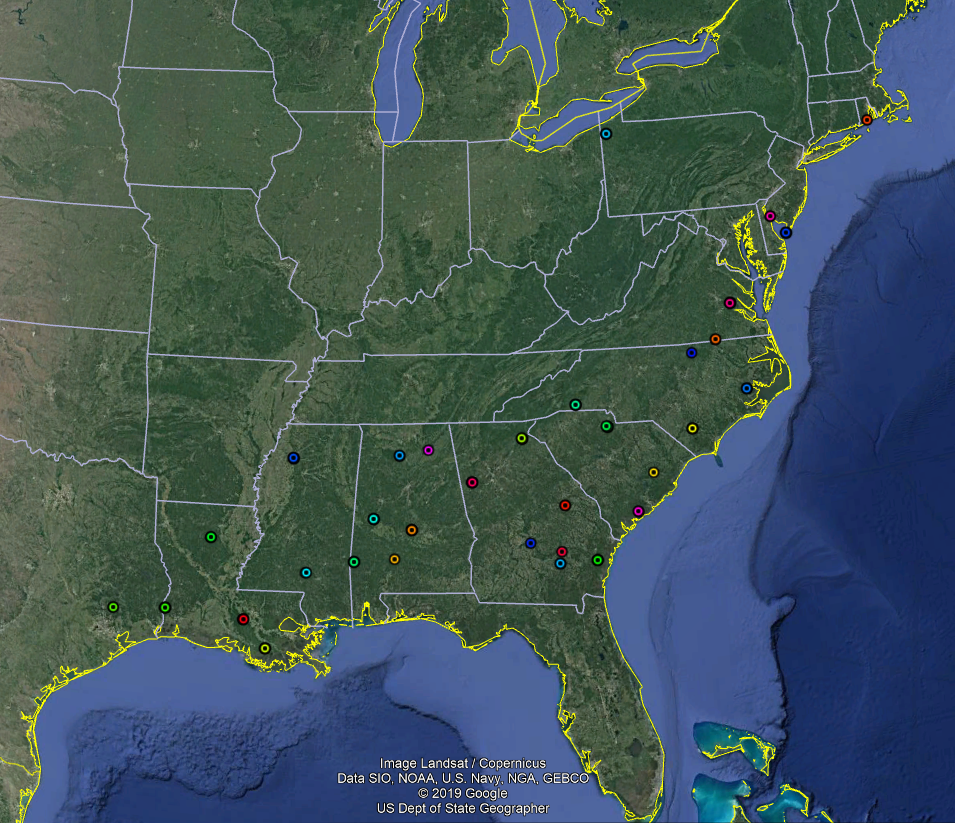Use the "Explore Data" button in the menu above to access visualizations of the movements described below!
Update 21 December. Only one bird made a movement this week; QUE-2020-21 moved from its stopover location in Kentucky (where it's spent the last 6 weeks) and flew south to Mississippi and then Louisiana. We're still expecting some movement from birds in Rhode Island and Virginia (west of the Appalachians) as fall migration draws to a close.
Update 14 December. Migration is starting to slow down as most of our birds settle into their winter ranges. The last marked bird left Pennsylvania this week, leaving Virginia and Rhode Island as the last two states with birds that haven't migrated. Our most interesting movement this week was from bird #RI-2020-44, which became the first marked bird from Rhode Island to make it as far west as Mississippi.
Update 8 December. This week several migrants entered the south-central United States, including Mississippi, Alabama, Louisiana, and Texas. Another migrant has made it to northern Florida (near Jacksonville) by flying off the coast of South Carolina. Our altitude readings suggest that, as of midnight on December 4th, the bird was flying 183 meters (600 feet) over the surface of the Atlantic.
Update 1 December. Birds are currently initiating migration in Pennsylvania, Rhode Island, and Virginia. Our early migrants from Quebec and Vermont are beginning to localize in the southeast US, likely in areas where they'll stay for the winter. Two birds also entered Tennessee this week. The first flew southwest from Ohio, while the second flew almost straight west from North Carolina, flying through the valleys of the Blue Ridge Mountains.
Update 23 November. Migration has picked up in Pennsylvania, where about half of our marked birds have left for warmer locales. Our first migrant from Virginia this year has also checked in from South Carolina. It's still a little early for the rest of the Virginia birds to move, but we expect the remaining Pennsylvania and Vermont birds to initiate migration within the next few weeks as things start to get a bit colder.
Update 18 November. Migration initiation is continuing in the northeast, as more birds report having left Quebec, Vermont, and Pennsylvania. We're expecting a number of new transmitters to come online in Virginia and Rhode Island this week as the initiation dates for these birds gets closer. We're also seeing the first few birds start to settle into their winter ranges in the southeast.
Update 11 November. Birds continue to initiate migration in the northeast, with the last few birds starting to leave Maine and Quebec for warmer climes. A major movement on Halloween weekend brought several birds from Quebec west into Ohio, Kentucky, and Illinois. Some may head back east as migration continues, but we expect that at least a few of these birds will spend the winter in the Mississippi Flyway.
Update 8 November. We saw major migratory movements associated with the remnants of Hurricane Zeta moving through the northeast around October 30th, and some of our more recent uploads have confirmed this. We currently have migrating birds strung out throughout New England, the mid-Atlantic, and into the southeast. As is typical for woodcock migration, we see some birds arriving at what might be their eventual wintering areas while others remain on the breeding grounds. We expect that now is the time for good numbers of migrant birds in southern New England and points further south.
Update 2 November. We saw major migratory movements late last week and over the weekend, with birds moving out of Canada and the northeastern states (ME, VT) and into southern New England and the Mid-Atlantic. These mass movements were probably driven by the weather system associated with the remnants of Hurricane Zeta, which moved through the northeast late last week. We currently have migrating birds strung out from Maine to Georgia, and we expect to pick up more information on migrant birds over the next few days. Resident woodcock from southern breeding areas like PA have been staying put for the most part, but we have observed one bird that left central PA on October 24th and arrived in central GA on November 1st.
Update 26 October 2020: Early migrants are continuing to move south out of Quebec and Vermont. One of these birds (VA-2019-47) is anticipated to cross Lake Ontario shortly. Currently our furthest moving migrant (VT-2020-17) has moved south from northeastern Vermont into central Virginia.
Update 23 October 2020: The first few migrants from Vermont and Quebec are beginning sporadic movements south. One bird summering in Quebec (VA-2019-47) has stopped over on the northern shore of Lake Ontario. This is a common strategy among migratory birds; this woodcock will rest, refuel, and wait for favorable northerly winds before it attempts to cross the Great Lake.
Update 20 October 2020: We've continued to see a few sporadic southward movements, including a few birds trickling out of Canada into the US, and one bird marked in northern Vermont that has migrated to Massachusetts. Most birds remain stationary, but we expect to have more frequent movements over the coming weeks. In general it seems we may see a relatively early start to fall migration this year, but only the birds will tell us for sure over the next few weeks.
Update 15 October 2020: Fall migration has officially begun, although we don't believe woodcock have yet begun moving south in large numbers. Over the past 10 days we saw our first movements of a few GPS-marked woodcock that traveled south out of Canada into NY and PA. Most birds remain stationary, and with transmitters shifting to a frequent data collection schedule today we expect to have more frequent updates, and movements, over the coming weeks.
Update 5 October 2020: We've been working hard to deploy this fall's transmitters in Vermont, Maine, Virginia, West Virginia, Pennsylvania, Rhode Island, Quebec, Nova Scotia, and New Brunswick. As these new transmitters come online, their locations will be uploaded to the map below with frequent updates of woodcock locations beginning around October 15th.
Update 19 September 2020: We're currently about halfway through deploying this fall's transmitters, with collaborators working in Vermont, Maine, Virginia, West Virginia, Pennsylvania, Rhode Island, Quebec, Nova Scotia, and New Brunswick. As these new transmitters come online, their locations will be uploaded to the map below. Using our new interactive mapping tool, you can view the status of woodcock locations for a specific range of dates by toggling the slider below.
Update 10 September 2020: Over the summer our transmitters shift to a very infrequent location schedule to stretch out the last of their battery life. Most of the woodcock that are still transmitting have remained fairly stationary, but a few birds have made some unexpected movements, including a bird that spent much of the spring and summer in Maine but has recently moved south to Northern Virginia. Likewise, in late June a woodcock moved south out of New Hampshire and into Connecticut. We periodically see birds that surprise us and don't behave like they are 'supposed to' by making long-distance movements outside of the normal migratory periods, and these are good examples.
Beginning next week we will start marking birds in advance of fall migration, with deployments expected in Nova Scotia, New Brunswick, Quebec, Maine, Vermont, Pennsylvania, Rhode Island, Virginia and West Virginia. We don't anticipate major migratory movements until late October, but we will update this site as new location data become available.
The most recent location and general distribution of our marked birds are shown on the map below, and some past updates as well as our historic migration data are archived below.
For more information on the GPS-tracking technology that we use, visit our transmitter page.
Update 14 December. Migration is starting to slow down as most of our birds settle into their winter ranges. The last marked bird left Pennsylvania this week, leaving Virginia and Rhode Island as the last two states with birds that haven't migrated. Our most interesting movement this week was from bird #RI-2020-44, which became the first marked bird from Rhode Island to make it as far west as Mississippi.
Update 8 December. This week several migrants entered the south-central United States, including Mississippi, Alabama, Louisiana, and Texas. Another migrant has made it to northern Florida (near Jacksonville) by flying off the coast of South Carolina. Our altitude readings suggest that, as of midnight on December 4th, the bird was flying 183 meters (600 feet) over the surface of the Atlantic.
Update 1 December. Birds are currently initiating migration in Pennsylvania, Rhode Island, and Virginia. Our early migrants from Quebec and Vermont are beginning to localize in the southeast US, likely in areas where they'll stay for the winter. Two birds also entered Tennessee this week. The first flew southwest from Ohio, while the second flew almost straight west from North Carolina, flying through the valleys of the Blue Ridge Mountains.
Update 23 November. Migration has picked up in Pennsylvania, where about half of our marked birds have left for warmer locales. Our first migrant from Virginia this year has also checked in from South Carolina. It's still a little early for the rest of the Virginia birds to move, but we expect the remaining Pennsylvania and Vermont birds to initiate migration within the next few weeks as things start to get a bit colder.
Update 18 November. Migration initiation is continuing in the northeast, as more birds report having left Quebec, Vermont, and Pennsylvania. We're expecting a number of new transmitters to come online in Virginia and Rhode Island this week as the initiation dates for these birds gets closer. We're also seeing the first few birds start to settle into their winter ranges in the southeast.
Update 11 November. Birds continue to initiate migration in the northeast, with the last few birds starting to leave Maine and Quebec for warmer climes. A major movement on Halloween weekend brought several birds from Quebec west into Ohio, Kentucky, and Illinois. Some may head back east as migration continues, but we expect that at least a few of these birds will spend the winter in the Mississippi Flyway.
Update 8 November. We saw major migratory movements associated with the remnants of Hurricane Zeta moving through the northeast around October 30th, and some of our more recent uploads have confirmed this. We currently have migrating birds strung out throughout New England, the mid-Atlantic, and into the southeast. As is typical for woodcock migration, we see some birds arriving at what might be their eventual wintering areas while others remain on the breeding grounds. We expect that now is the time for good numbers of migrant birds in southern New England and points further south.
Update 2 November. We saw major migratory movements late last week and over the weekend, with birds moving out of Canada and the northeastern states (ME, VT) and into southern New England and the Mid-Atlantic. These mass movements were probably driven by the weather system associated with the remnants of Hurricane Zeta, which moved through the northeast late last week. We currently have migrating birds strung out from Maine to Georgia, and we expect to pick up more information on migrant birds over the next few days. Resident woodcock from southern breeding areas like PA have been staying put for the most part, but we have observed one bird that left central PA on October 24th and arrived in central GA on November 1st.
Update 26 October 2020: Early migrants are continuing to move south out of Quebec and Vermont. One of these birds (VA-2019-47) is anticipated to cross Lake Ontario shortly. Currently our furthest moving migrant (VT-2020-17) has moved south from northeastern Vermont into central Virginia.
Update 23 October 2020: The first few migrants from Vermont and Quebec are beginning sporadic movements south. One bird summering in Quebec (VA-2019-47) has stopped over on the northern shore of Lake Ontario. This is a common strategy among migratory birds; this woodcock will rest, refuel, and wait for favorable northerly winds before it attempts to cross the Great Lake.
Update 20 October 2020: We've continued to see a few sporadic southward movements, including a few birds trickling out of Canada into the US, and one bird marked in northern Vermont that has migrated to Massachusetts. Most birds remain stationary, but we expect to have more frequent movements over the coming weeks. In general it seems we may see a relatively early start to fall migration this year, but only the birds will tell us for sure over the next few weeks.
Update 15 October 2020: Fall migration has officially begun, although we don't believe woodcock have yet begun moving south in large numbers. Over the past 10 days we saw our first movements of a few GPS-marked woodcock that traveled south out of Canada into NY and PA. Most birds remain stationary, and with transmitters shifting to a frequent data collection schedule today we expect to have more frequent updates, and movements, over the coming weeks.
Update 5 October 2020: We've been working hard to deploy this fall's transmitters in Vermont, Maine, Virginia, West Virginia, Pennsylvania, Rhode Island, Quebec, Nova Scotia, and New Brunswick. As these new transmitters come online, their locations will be uploaded to the map below with frequent updates of woodcock locations beginning around October 15th.
Update 19 September 2020: We're currently about halfway through deploying this fall's transmitters, with collaborators working in Vermont, Maine, Virginia, West Virginia, Pennsylvania, Rhode Island, Quebec, Nova Scotia, and New Brunswick. As these new transmitters come online, their locations will be uploaded to the map below. Using our new interactive mapping tool, you can view the status of woodcock locations for a specific range of dates by toggling the slider below.
Update 10 September 2020: Over the summer our transmitters shift to a very infrequent location schedule to stretch out the last of their battery life. Most of the woodcock that are still transmitting have remained fairly stationary, but a few birds have made some unexpected movements, including a bird that spent much of the spring and summer in Maine but has recently moved south to Northern Virginia. Likewise, in late June a woodcock moved south out of New Hampshire and into Connecticut. We periodically see birds that surprise us and don't behave like they are 'supposed to' by making long-distance movements outside of the normal migratory periods, and these are good examples.
Beginning next week we will start marking birds in advance of fall migration, with deployments expected in Nova Scotia, New Brunswick, Quebec, Maine, Vermont, Pennsylvania, Rhode Island, Virginia and West Virginia. We don't anticipate major migratory movements until late October, but we will update this site as new location data become available.
The most recent location and general distribution of our marked birds are shown on the map below, and some past updates as well as our historic migration data are archived below.
For more information on the GPS-tracking technology that we use, visit our transmitter page.
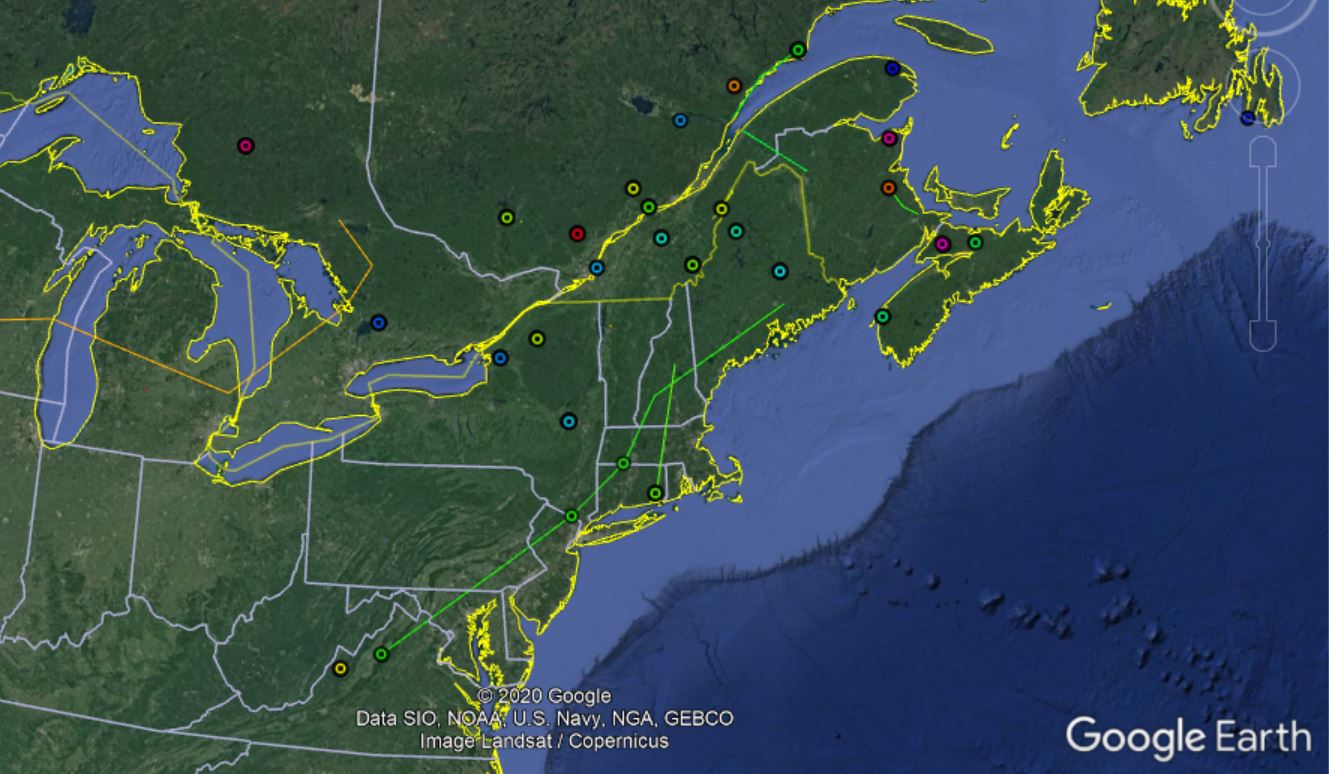
Update 1 June 2020: This will be the last spring 2020 migration update. No new migratory movements have been documented over the weekend and this largely adheres to previous updates, the woodcock have finished migration. While some individuals may continue to move large distances over the summer, as observed the past two years, these movements are likely related to post-breeding molt migrations.
Spring 2020 has a been for lack of other words, unprecedented. We were fortunate to have deployed our last transmitters prior to quarantine efforts designed to stem the spread of COVID-19. Our capture efforts in January-February resulted in an amazing number of woodcock captured. We monitored woodcock migrating through and into three states new to the project and three Canadian provinces new to the project. We tracked birds to the far eastern breeding extent (Newfoundland) and to almost the western breeding extent (Manitoba).
Our project partners, collaborators, and volunteers have been instrumental in building momentum and we are already eagerly looking forward to Fall 2020. Thank you to all of our supporters and everyone who follows our twice weekly migration updates. Yours interests keep our fires burning, have a safe and healthy summer!

Update 28 May 2020: No new migratory movement observed. Birds have only moved locally over the past few days.

Update 26 May 2020: The only recent woodcock migratory movement we documented, was a bird leaving southern Michigan and moving to the Quebec/Ontario Boarder. The only other movements we observed were local. Migration has largely subsided but a subset of woodcock are continuing to preform migratory movements.
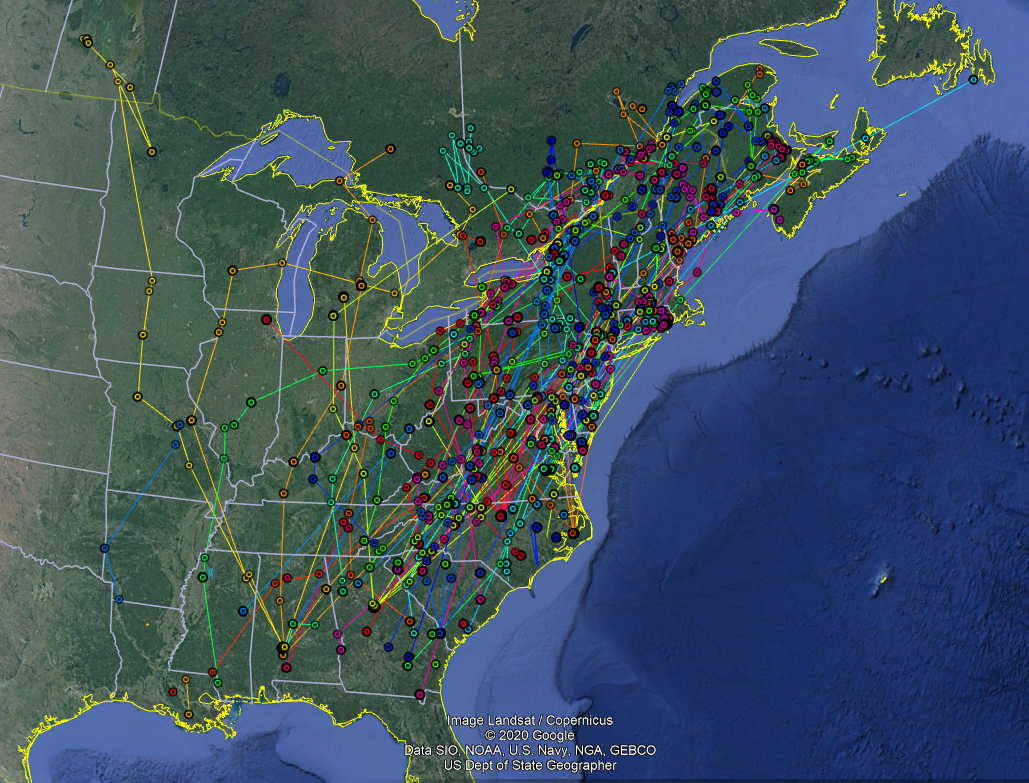
Update 21 May 2020: The only migratory movement observed was from a male woodcock marked in western Virginia. He has spent the last 2 months in Virginia, and just flew 1,135 km to southeastern Quebec. He likely made the trip over a few days, but because we are only collecting infrequent locations from birds, we did not document his stopover locations.
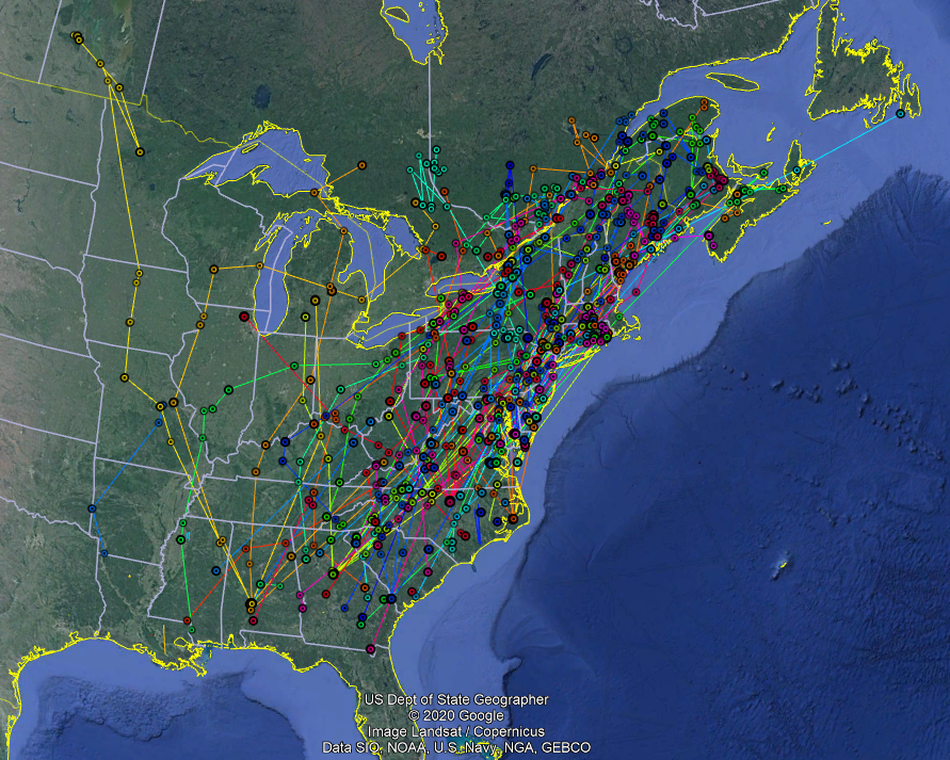
Update 18 May 2020: One woodcock moved from southern Ontario to southern Quebec and another that was on Prince Edward Island has flown back to New Brunswick. Otherwise, most woodcock have settled into residency and are only moving locally.

Update 14 May 2020: Most marked woodcock are still primarily uploading local movements. But one woodcock that had been in northern New York for over a month has migrated into eastern Quebec near the St. Lawrence River.

Update 11 May 2020: Little to no migratory activity was observed this weekend. We are curious to see how the late season snowstorm that blanketed much of the northeast in a few inches of snow will affect woodcock. But we may need to wait a few days for transmitters to upload locations.

Update 8 May 2020: Woodcock are continuing to move locally with very little migration activity. One woodcock in central Pennsylvania has moved into southern Quebec, but that is really the only migratory movement of note.
Many of the females marked last winter appear to be on nests, as locations are clustered in ~10-20 meter areas for between 2-4 weeks. Woodcock broods have been encountered in east-central Maine for the past few days, in what is likely a 'pulse' of hatching nests. We expect a similar 'pulse' of hatching nests across southern Ontario and parts of southern Quebec. However persistent snow cover has likely delayed nesting in many parts of southern Quebec.
Many of the females marked last winter appear to be on nests, as locations are clustered in ~10-20 meter areas for between 2-4 weeks. Woodcock broods have been encountered in east-central Maine for the past few days, in what is likely a 'pulse' of hatching nests. We expect a similar 'pulse' of hatching nests across southern Ontario and parts of southern Quebec. However persistent snow cover has likely delayed nesting in many parts of southern Quebec.

Update 4 May 2020: Most movements over the past few days have been local, however one woodcock that had been in Michigan for longer than a month has flown in to south central Ontario.

Update 1 May 2020: Relatively little migratory movement has occurred this past week. One of the juvenile males in New Brunswick moved onto Prince Edward Island, for a province-project first.
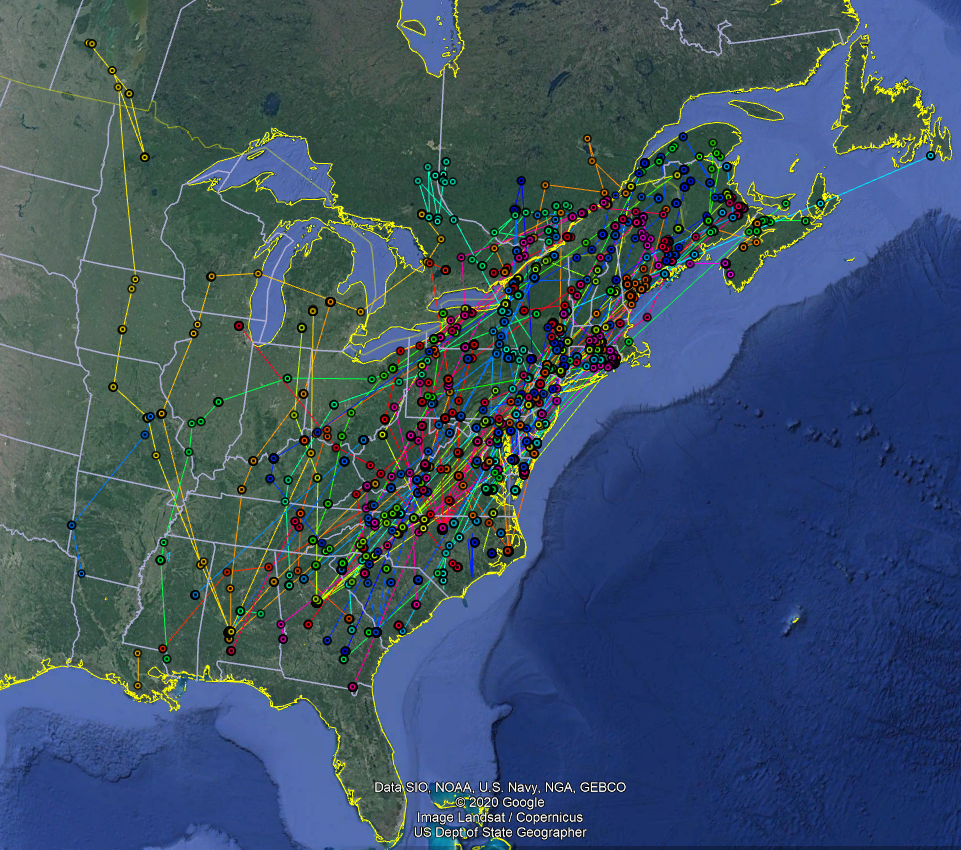
Update 27 April 2020: There has been limited migratory movements over the weekend, with a few birds moving around locally. The snow pack in much of southern Canada has been slow to recede and most woodcock are 'stalled' on the southern snow extent.
Over the weekend, a woodcock marked last winter in Alabama migrated into western Manitoba. Following the migration of a woodcock to Newfoundland last week, we currently have woodcock on the western and eastern breeding range extents.
Over the weekend, a woodcock marked last winter in Alabama migrated into western Manitoba. Following the migration of a woodcock to Newfoundland last week, we currently have woodcock on the western and eastern breeding range extents.
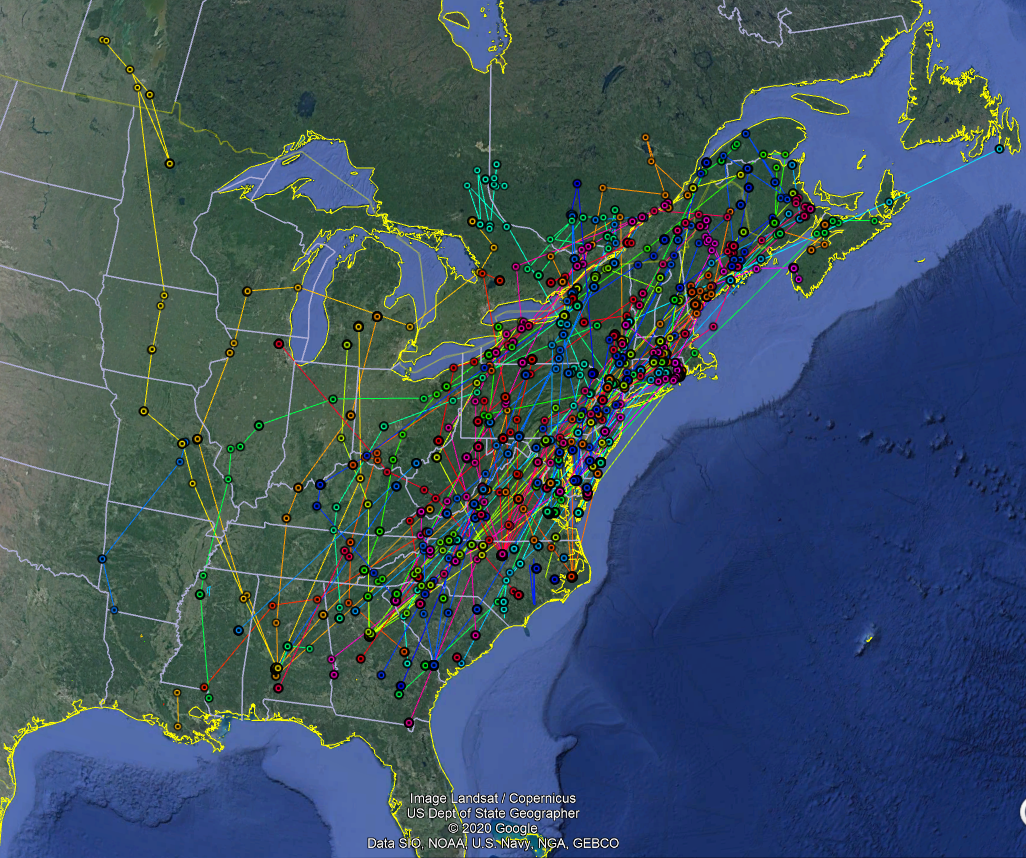
Update 23 April 2020: We have only observed a small amount of migratory movements of the past few days. But for a project first, one of the woodcock on Cape Breton Island in Nova Scotia has flown across the Gulf of St. Lawrence and is currently in Newfoundland! The juvenile male was captured in Cape May, New Jersey December 2019 and now he is literally on the edge of the species eastern range extent.
To get to Newfoundland, the woodcock would have preformed a fairly long ocean flight ranging from 60-320 miles (113-520 km). Over the past year, we have continued to build evidence that woodcock migrating from maritime Canada and along the eastern seaboard preform migratory flights over sections of the Atlantic ocean. Needless to say, this is pretty dang neat!
To get to Newfoundland, the woodcock would have preformed a fairly long ocean flight ranging from 60-320 miles (113-520 km). Over the past year, we have continued to build evidence that woodcock migrating from maritime Canada and along the eastern seaboard preform migratory flights over sections of the Atlantic ocean. Needless to say, this is pretty dang neat!

Update 20 April 2020: Over the past weekend, multiple woodcock have continued to migrate north into New Brunswick, northern Maine, and Quebec. One of the female woodcock marked last fall near Saquenay, Quebec has returned near her initial capture location. Additionally, a female marked near Tugg Hill in New York migrated north into Illinois, then flew east and is back in New York ~95 km from her capture location.
We are continuing to receive reports of woodcock recently hatched broods throughout the mid-Atlantic and southern New England. And a brood was sighted near Charleston, SC, likely nearing brood break-up (independence from mom). Meanwhile, other females are just returning to their breeding locations in southern Canada. Pretty incredible variability.
We are continuing to receive reports of woodcock recently hatched broods throughout the mid-Atlantic and southern New England. And a brood was sighted near Charleston, SC, likely nearing brood break-up (independence from mom). Meanwhile, other females are just returning to their breeding locations in southern Canada. Pretty incredible variability.

Update 16 April 2020: Very little woodcock migratory movements has been observed during the past few days. Some woodcock are still following the receding snow cover north throughout most of southern Canada, but many birds appear to have entered residency periods and have not migrated in the past 1-2 weeks.

Update 13 April 2020: A winter storm hit much of northern New England (4/9-4/10), blanketing much of the area in snow. Many woodcock have not uploaded locations yet, but of the few that have, some birds appear to have remained near their last locations, while a few birds have either moved south or closer to the coasts in search of snow free areas. Hopefully we will gain a more comprehensive picture in the next few days. Otherwise, a few woodcock still in the southeast have continued moving north.
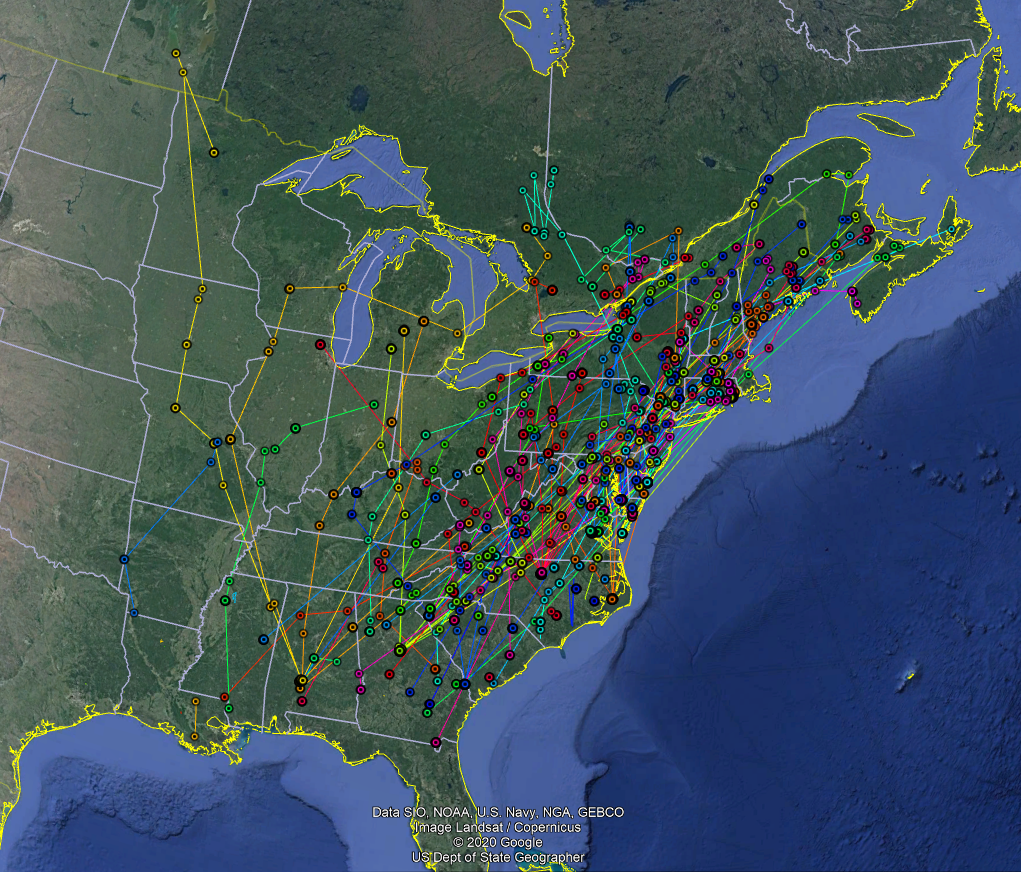
Update 9 April 2020: Over the past few days we have observed continual migratory movements into Maritime Canada and woodcock are migrating into both western and northern Maine. There has been less movement activity in southern Quebec and Ontario, but locally birds seems to be exploring non-snow covered areas.
A few woodcock that have been stationary in South Carolina, and other states in the southeastern US have initiated migration. So, there are still woodcock in the southeast and they are slowly making their way north. We have also received females with broods in Georgia, Virginia, and even Rhode Island! Two females with failed broods from Virginia began migrating north shortly after loosing them.
A few woodcock that have been stationary in South Carolina, and other states in the southeastern US have initiated migration. So, there are still woodcock in the southeast and they are slowly making their way north. We have also received females with broods in Georgia, Virginia, and even Rhode Island! Two females with failed broods from Virginia began migrating north shortly after loosing them.
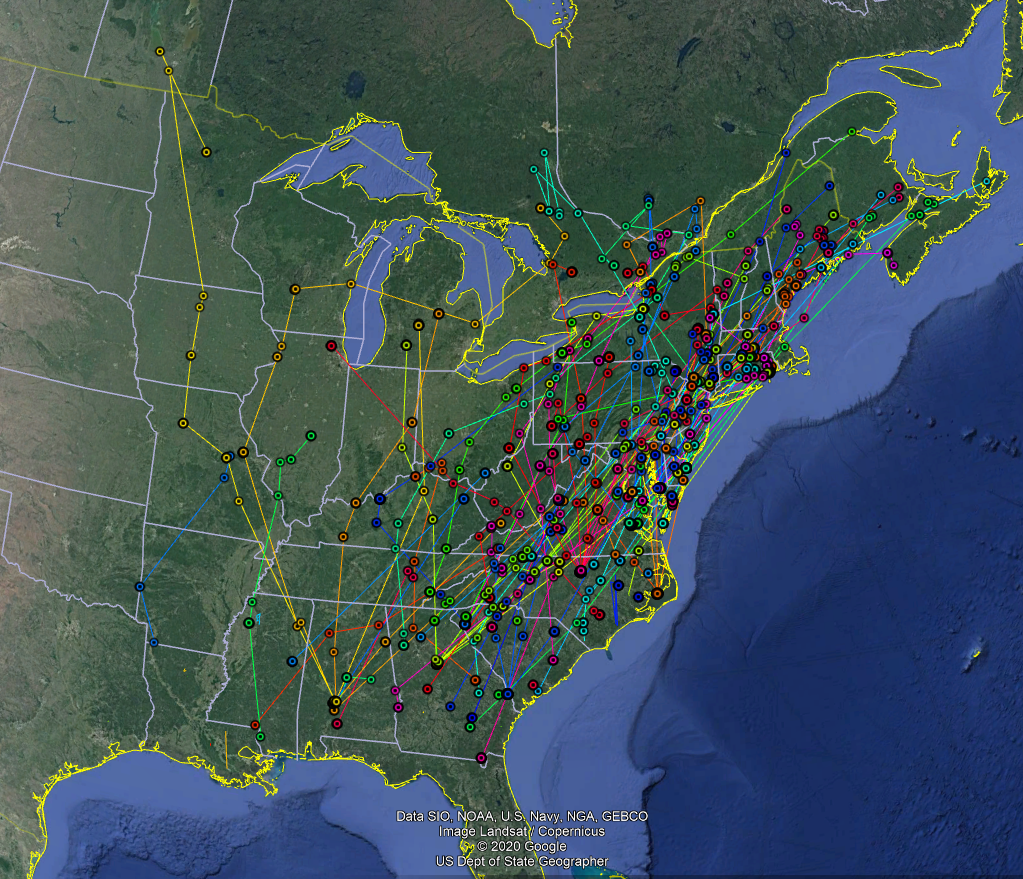
Update 6 April 2020: Woodcock are continuing to slowly migrate north, but many birds are encountering snow in the Great Lakes, New England, and southern Canada. We have observed a number of 'reverse migrations' where birds north, then retreat south to avoid snow.
More woodcock are migrating into New Brunswick and Nova Scotia, but are generally restricted to coastal area, due to snow.
A few woodcock marked this past fall have returned to breeding areas west of the Adirondacks and north of Buffalo, both in New York.
More woodcock are migrating into New Brunswick and Nova Scotia, but are generally restricted to coastal area, due to snow.
A few woodcock marked this past fall have returned to breeding areas west of the Adirondacks and north of Buffalo, both in New York.
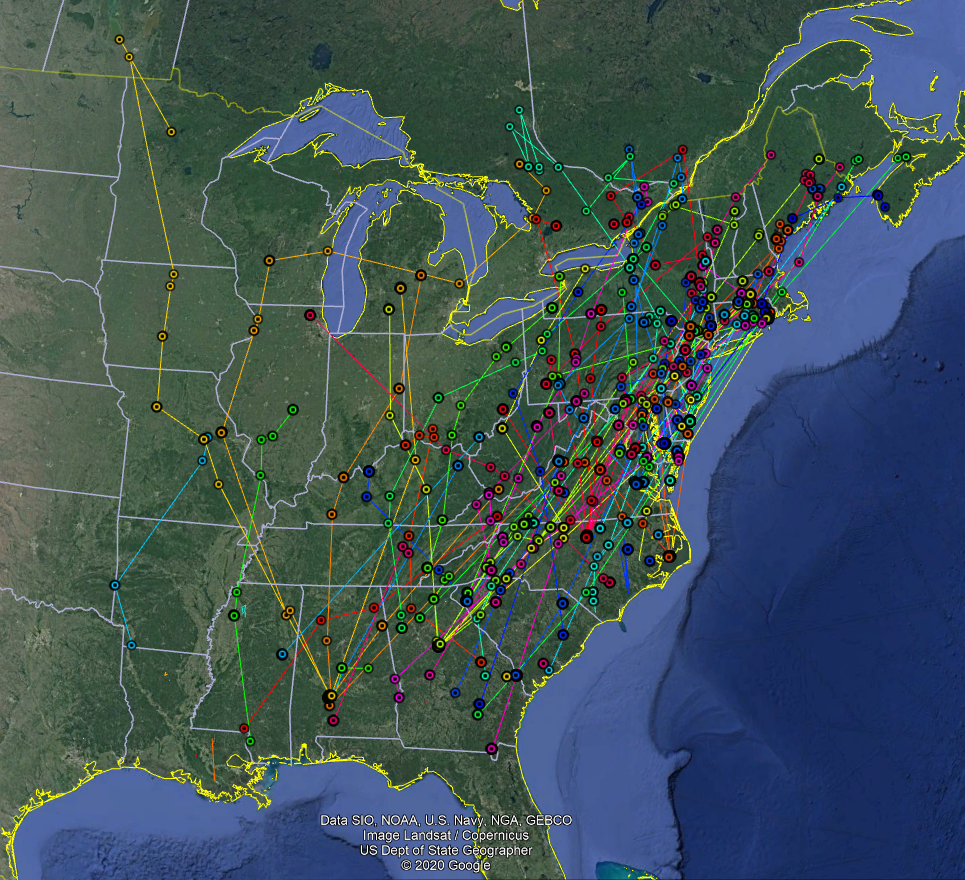
Update 2 April 2020: Woodcock are still continuing to move north, however the snow pack throughout much of southern Canada is slowing northward progress. The first marked woodcock of the year have arrived in Nova Scotia, New Brunswick, and for a project first... Manitoba!
We have also received reports of nesting woodcock in Rhode Island, and New York with reports of females with broods in Virginia and Alabama.
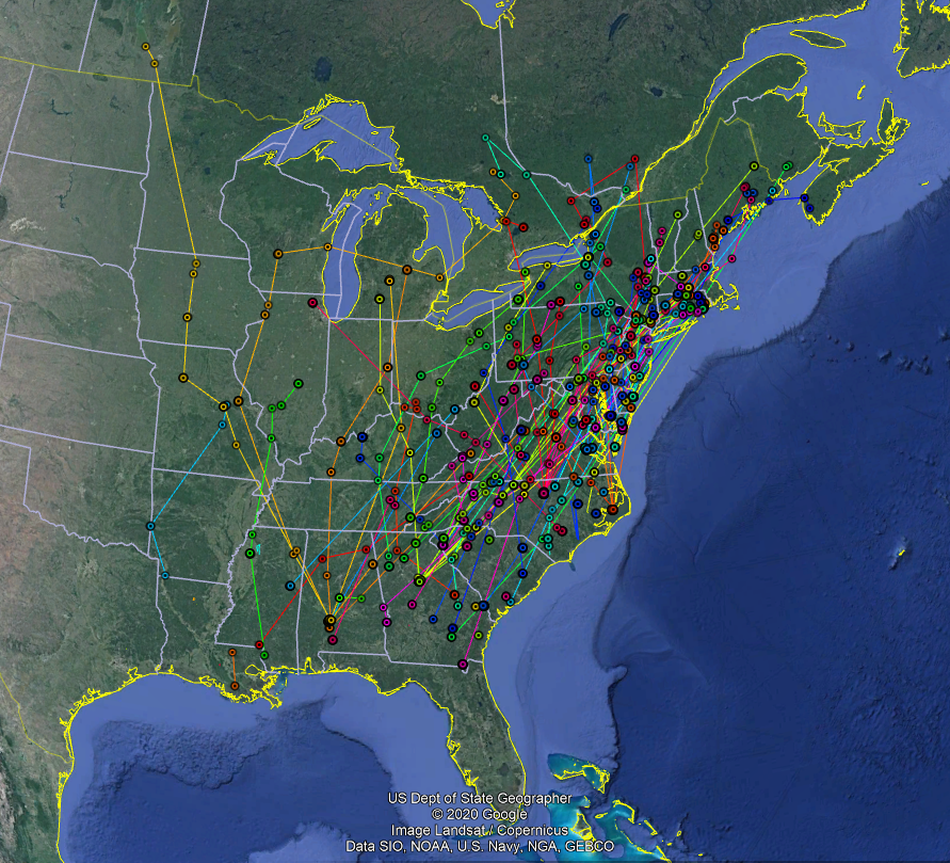
Update 30 March 2020: Woodcock are continuing to push north and a number of our marked birds are in southern Ontario and Quebec. More birds have also migrated into Maine and are continuing to follow the melting snow. Interesting, a number of woodcock in Quebec and Ontario have reverse migrated (flown south) after stopping over in relatively deep snow.
We collected a location of a woodcock migrating across the Gulf of Maine. The females left eastern Pennsylvania on the evening of 3/28, and arrived in Maine on 3/29. We do not know how frequently woodcock migration across oceans, but perhaps this behavior is more common the previously believed.

Update 23 March 2020: Woodcock are still moving north with new birds showing up in New England and the Great lake States. A few woodcock are still on the wintering grounds in GA, SC, NC, VA, and MD, but most have initiated migration. The greatest densities of birds appear to be in NY, PA, CT, NJ, MD, VA, and WV.
Woodcock on the northern extent are encountering snow pack in ME, NH, WI, and norther NY. It is unlikely that birds will continue to move north from these areas, with snow melt and warmer temperatures. However, some birds will likely migrate into snow covered areas, and concentrate activities near lowland seeps or wetlands.
Woodcock on the northern extent are encountering snow pack in ME, NH, WI, and norther NY. It is unlikely that birds will continue to move north from these areas, with snow melt and warmer temperatures. However, some birds will likely migrate into snow covered areas, and concentrate activities near lowland seeps or wetlands.
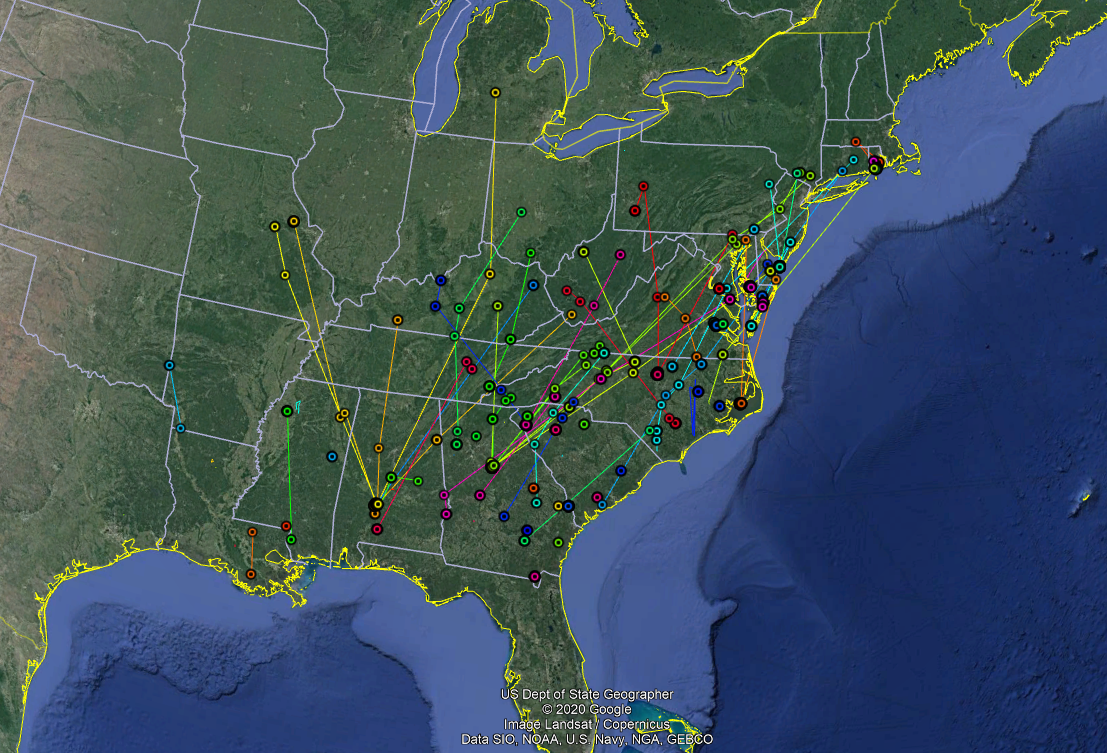
Update 20 March 2020: Woodcock have continued slowly migrating north over the past few days. A few woodcock have flow as far north as Wisconsin, Maine, and Michigan. More birds are continuing to arrive in southern New England and along the mid-Atlantic. As birds continue to move north they are arriving on the edge of the snow pack and will likely need to wait for the snow to melt before continuing further north.
We still have woodcock marked in Georgia, South Carolina, and North Carolina that have yet to initiate migration.
We still have woodcock marked in Georgia, South Carolina, and North Carolina that have yet to initiate migration.
Update 16 March 2020: Woodcock are continuing to leave their wintering areas and migrate north. About 1/3 of the woodcock marked this past winter have initiated migration. Large numbers of birds in the mid-Atlantic region (Maryland, Delaware, Pennsylvania, and New Jersey), with increasing number of birds in Southern New England (New York, Connecticut, Rhode Island, Massachusetts, and New Hampshire) and the Great Lake States (Pennsylvania, Ohio, Michigan, and Illinois).
For a project first, we have recorded stopover locations in Missouri, Iowa, and Oklahoma!
Interestingly, it appears that one woodcock that overwintered in Rhode Island has migrated west into Pennsylvania. We are hoping to confirm this movement with future data and to rule out a data transcription error, but super interesting nonetheless.
For a project first, we have recorded stopover locations in Missouri, Iowa, and Oklahoma!
Interestingly, it appears that one woodcock that overwintered in Rhode Island has migrated west into Pennsylvania. We are hoping to confirm this movement with future data and to rule out a data transcription error, but super interesting nonetheless.
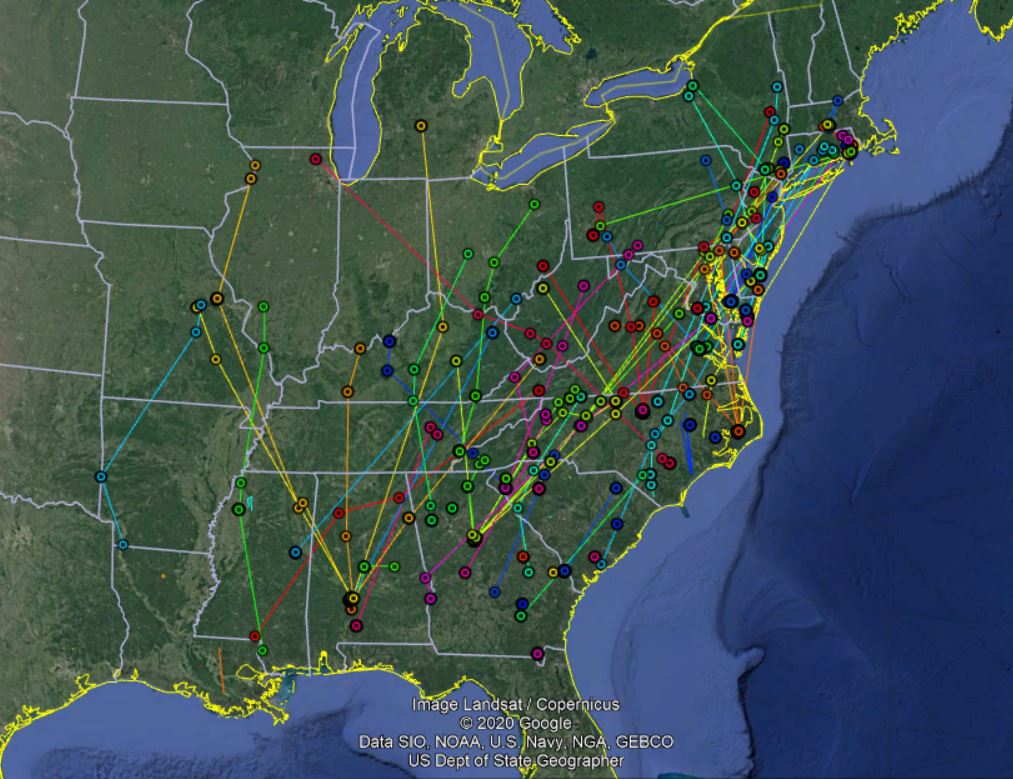
Update 12 March 2020: Woodcock are continuing to migrate into east-central states, with increasing numbers of birds in West Virginia, Tennessee, Kentucky, Virginia, and North Carolina. Additional, woodcock are starting to arrive in Great Lake and New England states. Namely, Ohio, Michigan, Pennsylvania, New Jersey, New York, Connecticut, Delaware, and Rhode Island.
A handful of woodcock are still on the wintering grounds in Alabama, Georgia, and South Carolina. With greater numbers of birds still near capture sites in North Carolina, Virginia, and Maryland.
Regardless woodcock migration is picking up steam and birds are continuing to move further north.
Update 9 March 2020: Migration is continuing to pick up steam with additional woodcock migrating into Kentucky, Tennessee, Missouri, West Virginia, Pennsylvania, and New York. Increasing numbers of woodcock this past winter are leaving Alabama, Georgia, and the Carolinas.
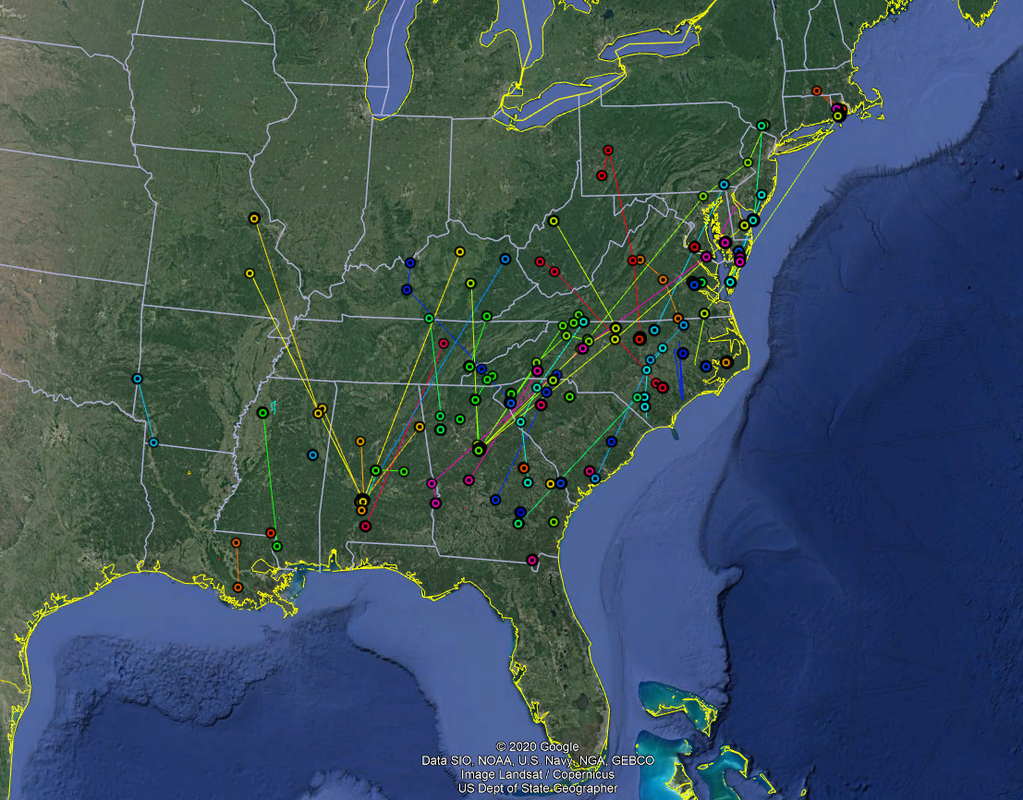
Update 4 March 2020: A few more woodcock are starting to initiate migration, however most birds are still at their wintering site. Most notable, a number of woodcock are migrating through western North Carolina. A few additional birds have moved into Kentucky, Tennessee, West Virginia, and even New York.
Update 29 February 2020: Very little migratory movement has occurred in the past week. One woodcock left Georgia and is currently in Delaware, but otherwise most birds have been stationary. We have recently deployed transmitters in South Carolina and Maryland this past week.
We are just waiting on warmer weather to push woodcock north.
We are just waiting on warmer weather to push woodcock north.

Update 21 February 2020: An increasing number of birds have continued to begin their northward migration. Noteworthy this week is a male woodcock marked in Alabama early this month that has migrated north into Missouri. Other birds have moved short distances north out of Georgia, South Carolina, and North Carolina. Most of our marked birds, however, remain on their wintering areas throughout the southeastern U.S.
We've added newly marked woodcock over the past weeks in Georgia, Alabama, and North Carolina, and we hope to increase that number in the coming weeks in South Carolina and Maryland.
We've added newly marked woodcock over the past weeks in Georgia, Alabama, and North Carolina, and we hope to increase that number in the coming weeks in South Carolina and Maryland.
Update 15 February 2020: We've seen our first instances of early spring migrants moving out of southern wintering areas, including one bird that was marked in Rhode Island last fall, spent the winter in North Carolina, and has moved back to it's breeding area in the Ocean State. A few other birds have made relatively short northbound movements, but remain in southern wintering range. The majority of marked woodcock have not left their wintering areas. We've added 19 new marked woodcock over the past weeks in Georgia and Alabama, and we hope to add to that number in the coming weeks in North Carolina, South Carolina, and Maryland.
Update 17 January 2020: Over the past week, we have had a few more woodcock upload locations and are shown on the map below. Most tags are on battery saving mode and are only uploading locations periodically. We have had 4 woodcock upload locations from Rhode Island and we will have to see if they remain throughout the winter or if they eventually migrate south. Perhaps it will depend on winter weather and how much freezing southern Rhode Island receives.
We documented 3 woodcock moving ~150 km from their initial wintering locations north to new areas. We will have to wait and see if the birds remain in these areas, or if they return to the first area used.
We documented 3 woodcock moving ~150 km from their initial wintering locations north to new areas. We will have to wait and see if the birds remain in these areas, or if they return to the first area used.
Update 10 January 2020: Below is the distribution of woodcock that have uploaded locations in the past 10 days and highlights the wintering range of woodcock marked in Eastern North America. Interestingly about one-third of the woodcock marked in the Eastern Management Region are overwintering in the Central Management Region (Alabama, Mississippi, Louisiana, and Texas).
Update 6 January 2020: Fall migration has largely ended and the next series of project updates will focus on mid-winter movements (movements from one wintering sites to another). All locations shown have been collected beginning January 01. Many transmitters have entered a battery saving mode and will only take intermittent locations throughout the winter, and begin frequent location collection for spring migration. However some tags will continue to collect one location a day until the battery dies.
Most woodcock are currently in states along the Gulf of Mexico and the southern-Atlantic. However, some woodcock are still in the Mid-Atlantic region.
Most woodcock are currently in states along the Gulf of Mexico and the southern-Atlantic. However, some woodcock are still in the Mid-Atlantic region.
Copyright © 2024 Eastern Woodcock Migration Research Cooperative.
All Rights Reserved.
All Rights Reserved.
